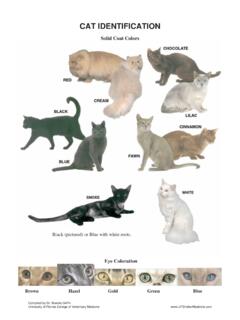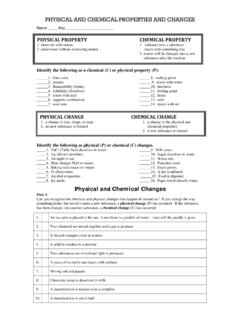Transcription of METHOD 22 VISUAL DETERMINATION OF FUGITIVE …
1 METHOD 22 1/14/2019. While we have taken steps to ensure the accuracy of this Internet version of the document, it is not the official version. To see a complete version including any recent edits, visit: and search under Title 40, Protection of Environment. METHOD 22 VISUAL DETERMINATION OF FUGITIVE EMISSIONS FROM MATERIAL SOURCES. AND smoke EMISSIONS FROM FLARES. NOTE: This METHOD is not inclusive with respect to observer certification. Some material is incorporated by reference from METHOD 9. Scope and Application This METHOD is applicable for the DETERMINATION of the frequency of FUGITIVE emissions from stationary sources, only as specified in an applicable subpart of the regulations. This METHOD also is applicable for the DETERMINATION of the frequency of visible smoke emissions from flares. Summary of METHOD FUGITIVE emissions produced during material processing, handling, and transfer operations or smoke emissions from flares are visually determined by an observer without the aid of instruments.
2 This METHOD is used also to determine visible smoke emissions from flares used for combustion of waste process materials. This METHOD determines the amount of time that visible emissions occur during the observation period ( , the accumulated emission time). This METHOD does not require that the opacity of emissions be determined. Since this procedure requires only the DETERMINATION of whether visible emissions occur and does not require the DETERMINATION of opacity levels, observer certification according to the procedures of METHOD 9 is not required. However, it is necessary that the observer is knowledgeable with respect to the general procedures for determining the presence of visible emissions. At a minimum, the observer must be trained and knowledgeable regarding the effects of background contrast, ambient lighting, observer position relative to lighting, wind, and the presence of uncombined water (condensing water vapor) on the visibility of emissions.
3 This training is to be obtained from written materials found in References 1 and 2 or from the lecture portion of the METHOD 9 certification course. Definitions Emission frequency means the percentage of time that emissions are visible during the observation period. Emission time means the accumulated amount of time that emissions are visible during the observation period. METHOD 22 1/14/2019. FUGITIVE emissions means emissions generated by an affected facility which is not collected by a capture system and is released to the atmosphere. This includes emissions that (1) escape capture by process equipment exhaust hoods; (2) are emitted during material transfer; (3) are emitted from buildings housing material processing or handling equipment; or (4) are emitted directly from process equipment. Observation period means the accumulated time period during which observations are conducted, not to be less than the period specified in the applicable regulation.
4 smoke emissions means a pollutant generated by combustion in a flare and occurring immediately downstream of the flame. smoke occurring within the flame, but not downstream of the flame, is not considered a smoke emission. Interferences Occasionally, FUGITIVE emissions from sources other than the affected facility ( , road dust). may prevent a clear view of the affected facility. This may particularly be a problem during periods of high wind. If the view of the potential emission points is obscured to such a degree that the observer questions the validity of continuing observations, then the observations shall be terminated, and the observer shall clearly note this fact on the data form. Safety Disclaimer. This METHOD may involve hazardous materials, operations, and equipment. This test METHOD may not address all of the safety problems associated with its use. It is the responsibility of the user of this test METHOD to establish appropriate safety and health practices and determine the applicability of regulatory limitations prior to performing this test METHOD .
5 Equipment Stopwatches (two). Accumulative type with unit divisions of at least seconds. Light Meter. Light meter capable of measuring illuminance in the 50 to 200 lux range, required for indoor observations only. Reagents and Supplies [Reserved]. Sample Collection, Preservation, Storage, and Transfer [Reserved]. Quality Control [Reserved]. Calibration and Standardization [Reserved]. Analytical Procedure Selection of Observation Location. Survey the affected facility, or the building or structure housing the process to be observed, and determine the locations of potential emissions. If the METHOD 22 1/14/2019. affected facility is located inside a building, determine an observation location that is consistent with the requirements of the applicable regulation ( , outside observation of emissions escaping the building/structure or inside observation of emissions directly emitted from the affected facility process unit).
6 Then select a position that enables a clear view of the potential emission point(s) of the affected facility or of the building or structure housing the affected facility, as appropriate for the applicable subpart. A position at least m (15 feet), but not more than 400 m ( miles), from the emission source is recommended. For outdoor locations, select a position where the sunlight is not shining directly in the observer's eyes. Field Records. Outdoor Location. Record the following information on the field data sheet (Figure 22-1): Company name, industry, process unit, observer's name, observer's affiliation, and date. Record also the estimated wind speed, wind direction, and sky condition. Sketch the process unit being observed, and note the observer location relative to the source and the sun. Indicate the potential and actual emission points on the sketch. Alternatively, digital photography as described in section may be used for a subset of the recordkeeping requirements of this section.
7 Indoor Location. Record the following information on the field data sheet (Figure 22-2): Company name, industry, process unit, observer's name, observer's affiliation, and date. Record as appropriate the type, location, and intensity of lighting on the data sheet. Sketch the process unit being observed, and note the observer location relative to the source. Indicate the potential and actual FUGITIVE emission points on the sketch. Alternatively, digital photography as described in section may be used for a subset of the recordkeeping requirements of this section. Digital Photographic Records. Digital photographs, annotated or unaltered, may be used to record and report sky conditions, observer's location relative to the source, observer's location relative to the sun, process unit being observed, potential emission points and actual emission points for the requirements in sections and The image must have the proper lighting, field of view and depth of field to properly distinguish the sky condition (if applicable), process unit, potential emission point and actual emission point.
8 At least one digital photograph must be from the point of the view of the observer. The photograph(s) representing the environmental conditions including the sky conditions and the position of the sun relative to the observer and the emission point must be taken within a reasonable time of the observation ( , 15 minutes). When observations are taken from exactly the same observation point on a routine basis ( , daily) and as long as there are no modifications to the units depicted, only a single photograph each is necessary to document the observer's location relative to the emissions source, the process unit being observed, and the location of potential and actual emission points . Any photographs altered or annotated must be retained in an unaltered format for recordkeeping purposes. Indoor Lighting Requirements. For indoor locations, use a light meter to measure the level of illumination at a location as close to the emission source(s) as is feasible.
9 An illumination of greater than 100 lux (10 foot candles) is considered necessary for proper application of this METHOD . METHOD 22 1/14/2019. Observations. Procedure. Record the clock time when observations begin. Use one stopwatch to monitor the duration of the observation period. Start this stopwatch when the observation period begins. If the observation period is divided into two or more segments by process shutdowns or observer rest breaks (see section ), stop the stopwatch when a break begins and restart the stopwatch without resetting it when the break ends. Stop the stopwatch at the end of the observation period. The accumulated time indicated by this stopwatch is the duration of observation period. When the observation period is completed, record the clock time. During the observation period, continuously watch the emission source. Upon observing an emission (condensed water vapor is not considered an emission), start the second accumulative stopwatch; stop the watch when the emission stops.
10 Continue this procedure for the entire observation period. The accumulated elapsed time on this stopwatch is the total time emissions were visible during the observation period ( , the emission time.). Observation Period. Choose an observation period of sufficient length to meet the requirements for determining compliance with the emission standard in the applicable subpart of the regulations. When the length of the observation period is specifically stated in the applicable subpart, it may not be necessary to observe the source for this entire period if the emission time required to indicate noncompliance (based on the specified observation period) is observed in a shorter time period. In other words, if the regulation prohibits emissions for more than 6 minutes in any hour, then observations may (optional) be stopped after an emission time of 6 minutes is exceeded. Similarly, when the regulation is expressed as an emission frequency and the regulation prohibits emissions for greater than 10 percent of the time in any hour, then observations may (optional) be terminated after 6 minutes of emission are observed since 6.














